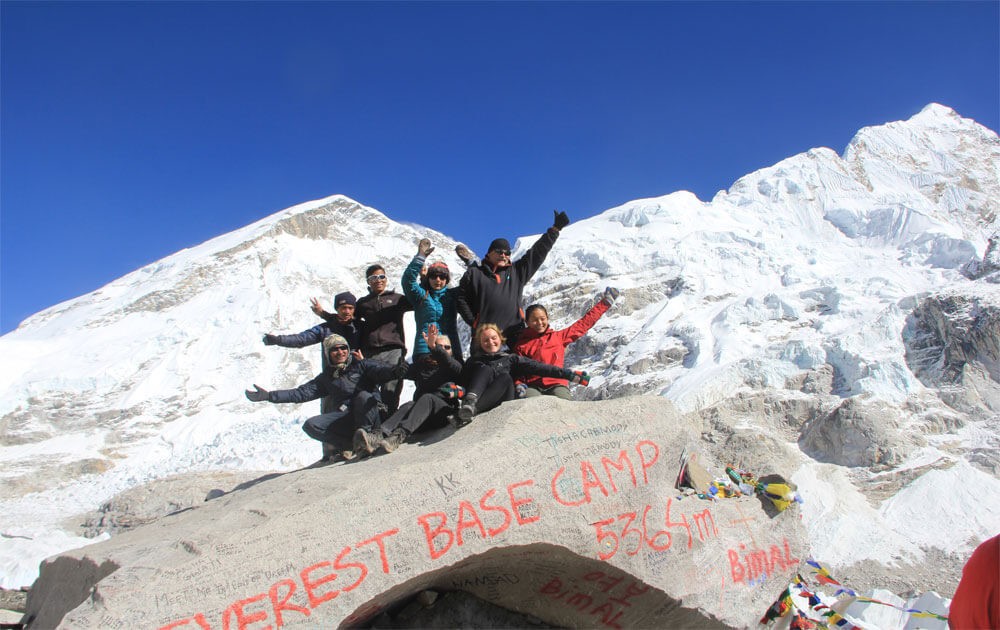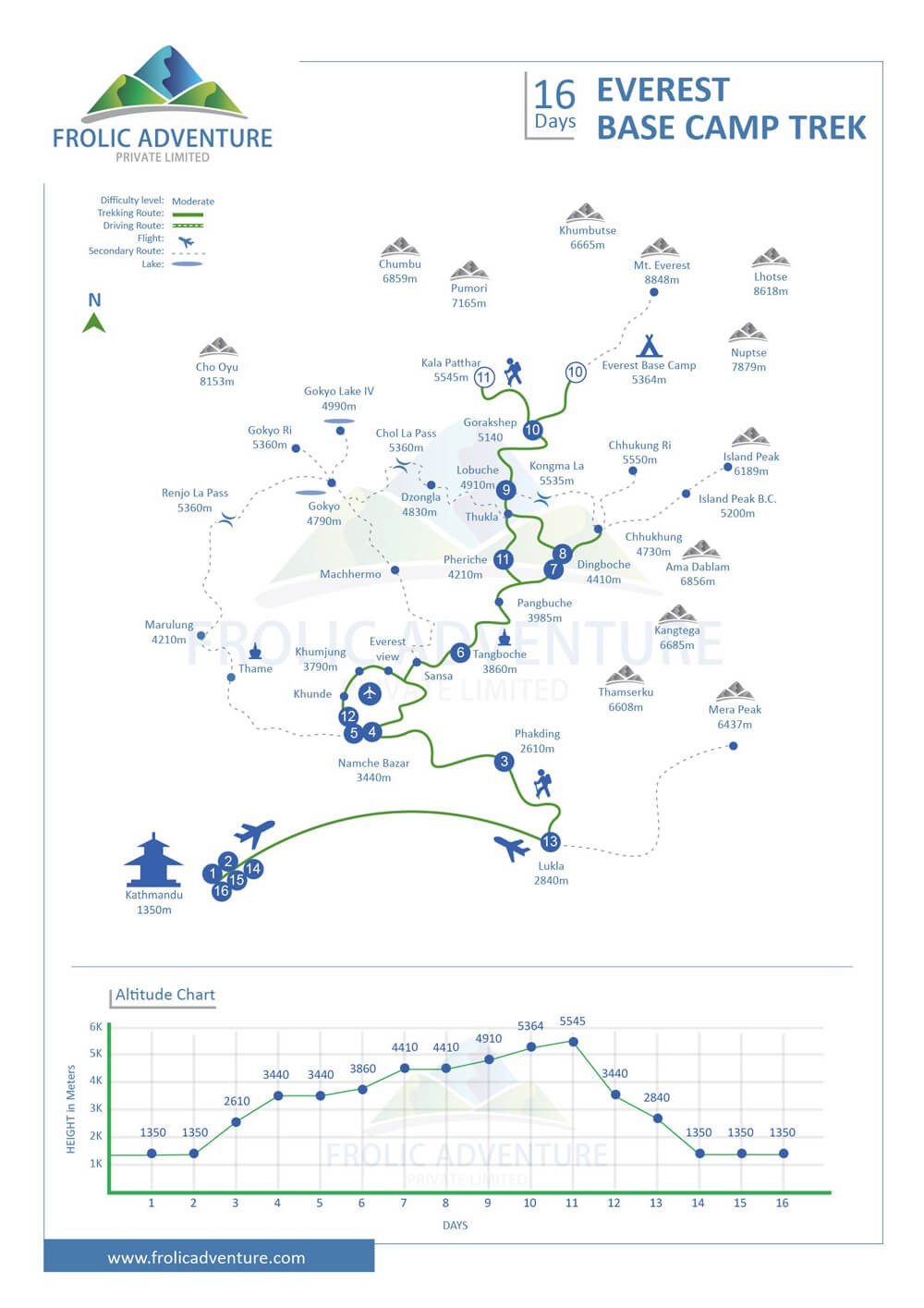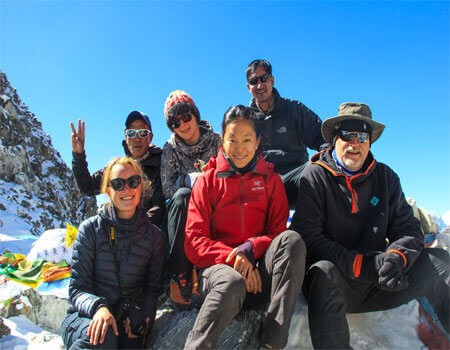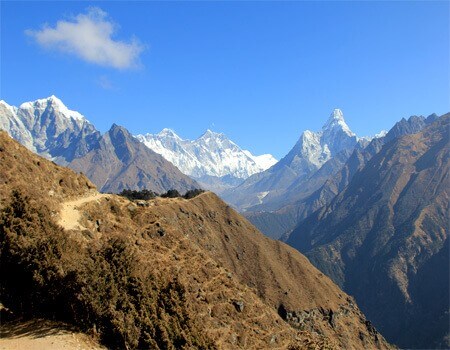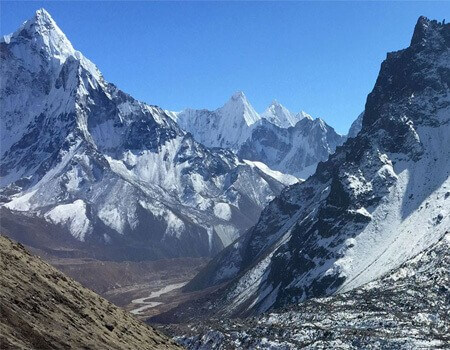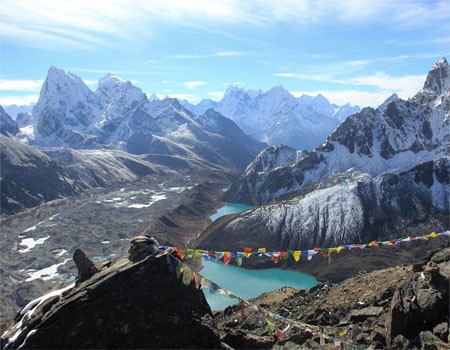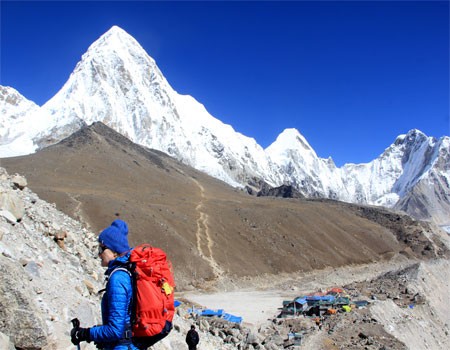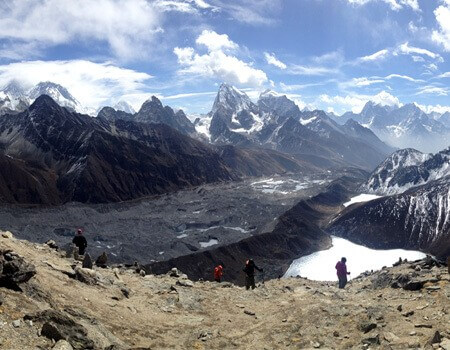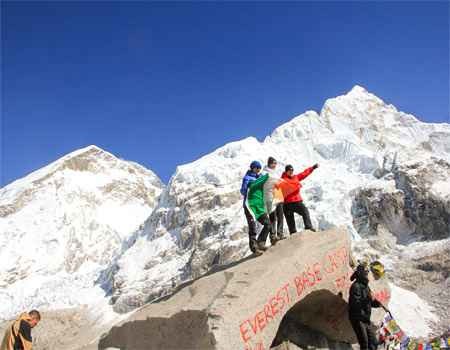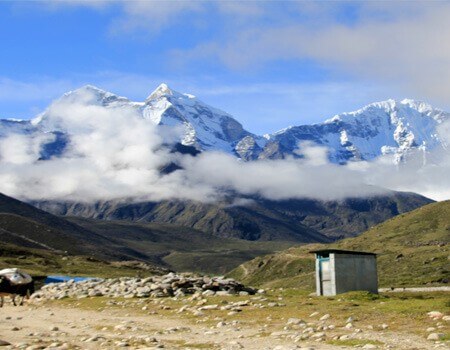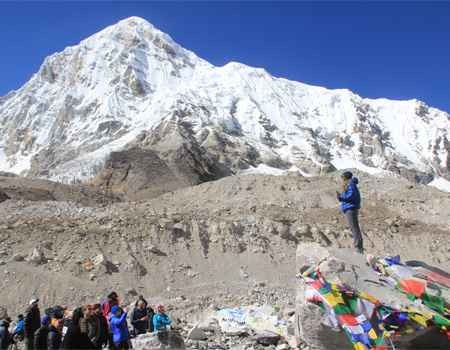The Everest Base Camp (EBC) Trek is one of the most popular and selected mountain trekking destinations in the Nepalese Himalayas. Mount Everest strongly represents Nepal with its elevation and expeditions.
There are thousands of adventure trekkers yearly, and hundreds each day during the high trekking seasons in this mountain route. The trekking itinerary is inside the Sagarmatha National Park, which is one of the natural UNESCO World Heritage Sites in Nepal.
It is a 12-day round trip from Kathmandu (the capital of Nepal). You begin the trip flying on a small aircraft to Lukla, either from Kathmandu or Ramechhap (Manthali). The flights operate from Ramechhap during the high season due to the pressure of too many trekkers. From October to November in autumn and from March to May in spring, flights depart from Manthali Airport. The rest of the time, flights depart from Kathmandu. However, you may have the opportunity to fly from Kathmandu if you are in a large group and book the space in advance, even during the high season.
Most Everest Trekkers and climbers prefer to fly directly from Kathmandu to Lukla because of the long and tiring drive to Ramechhap before and after the trek. However, only those who are lucky and have made advanced bookings may obtain direct tickets from Kathmandu. If you are planning a trip to the Everest Base Camp, think about driving for around four to six hours to the next airport on the first day.
After landing at Lukla Airport, you start walking towards Phakding with phenomenal views of some snow-capped peaks like Mt. Phari, Kongde, Numbur, and Kusum Kanguru while walking through charming Sherpa Villages like Chheplung, Thadokoshi, and Ghat.
Namche Bazaar, Tengboche, Pangboche, and Dingboche are the most attractive Sherpa Towns that you visit and explore during your EBC Trek. Cultural monuments, such as ancient religious monasteries, and other attractions, also contribute to the beauty of this adventure in these villages. The Locals from the Everest Region are the Sherpa, who are renowned for their expertise as mountain climbers. This trek offers you the opportunity to be part of their family and experience their lifestyle during a 12-day adventure.
Besides the culture and lifestyle of the locals, the natural attractions of the Everest Himalayas are the prime pull factors for visitors. Seeing Mt. Ama Dablam with its distinctive shape, alongside three of the world's highest mountains — Everest, Lhotse, and Makalu — above 8,000 meters — makes your trip unforgettable and a lifelong Himalayan Experience.
Is the Everest Base Camp Right Trek for You?
The Everest Base Camp is a moderate to strenuous trekking trip in Nepal. A regular hiker may not suffer from walking. Still, the altitude can make it difficult for a regular hiker who has not previously been over 4,000 meters above sea level. Sometimes, an elderly trekker can find it easier than an adult due to hiking experiences.
However, anyone can attempt the trek to Everest Base Camp by following our guide's guidance, which includes walking slowly, allowing for sufficient acclimatisation and altitude practice, staying warm, and drinking plenty of water while walking. We suggest this trek to everyone who is mentally prepared and physically fit.
Children above 8 years can also trek to Everest Base Camp. All adults and older people up to 70 years old can enjoy this trip with some hiking practice and physical training, ideally at least one month before attempting it.
What is the Best Time of Year to Trek to Everest Base Camp?
There are two major seasons to trek to Everest Base Camp. The pre-monsoon season, from March to May in the spring, and the post-monsoon season, from September to November in the autumn, are the best times for trekking in Nepal and the Everest Region.
Due to clear skies, bright mountain views, and almost no rain, the spring and autumn are ideal times for the trekkers to enjoy the trip without obstacles while walking in the mountains. Also, the operation of the Lukla flights will be smooth with fewer chances of delay and cancellations in these seasons.
Pre-Monsoon Season
March to May in spring is the pre-monsoon season in Nepal. It is the driest time in Nepal, and the major expedition festival in the Nepalese high mountains. However, there are hazy days in March due to no rain and forest fires, so long-distance visibility is not good in March. Still, you can see bright mountain views from a closer distance against the blue skies.
Spring makes colourful forests with blooming rhododendrons and other flowers. If you're scared of cold temperatures, spring can be the best time for you to trek to Everest Base Camp.
The spring offers many vibrant festivals in Nepal, such as Holi (a colour festival), coinciding with the Nepali New Year in April. You can celebrate festivals in Kathmandu before or after the trek in spring.
The trekking trail will be busy due to climbers and hundreds of trekkers, especially from mid-March to the end of April. We book the accommodation and Lukla flights in advance for our clients.
The base camp looks like a mini mountain city with colourful tents for the climbers in spring, so that you will encounter hundreds of summiters and record-holding Sherpas while walking, in the places you stay, and at the base camp. It will be longer daylight in spring, so you won't be in a rush to reach the camps while trekking in spring.
Post-Monsoon Season
Post-monsoon season means autumn in Nepal. It is the prime time to trek in the Nepalese Himalayas and to the Everest Base Camp. Summer rains from June to August clear the haze, keeping the environment clear and pleasant, so you can see bright mountain views even from a distance, surrounded by dark green scenery.
September is the first month of autumn, but there will still be some rainy days until the second week of this month in Nepal. The flights to Lukla can be delayed or cancelled due to the rain and fog at the beginning of September. However, it can't be the same situation every year because the weather can change quickly in the mountains.
October and November offer the best weather conditions in the Nepalese mountain regions and in the Everest Himalayas. However, the temperatures in the higher altitudes are significantly colder than those in the spring. If you want to have the best Everest Experience, we suggest trekking in October and November; however, the trail is crowded because everyone loves to do a trek without obstacles.
It is rare for the Lukla Flight to be delayed or canceled in October and November. It's not easy to get tickets for those who book at the last minute. Therefore, we suggest booking your space at least three months in advance. Additionally, accommodations in some places, such as Tengboche, Lobuche, and Gorak Shep, can be fully occupied due to the high volume of trekkers. We reserve the Lukla Flight ticket and the accommodation and operate the trip smoothly for our clients.
Autumn is the season of the major festivals in Nepal. Indra Jatra in September, when Kumari's (the living goddess) chariot will take a tour around the Kathmandu Durbar Square with a big crowd.
October and November offer the most significant Hindu festivals like Dashain and Tihar (Diwali), so you can celebrate the festivals with the locals while trekking to the Everest Base Camp if you are in the autumn in Nepal.
When is the Best Time to Trek without Crowds?
Summer and winter are the best times for those who love to trek in a quiet environment with minimal people. However, there are some difficulties during these times of weather and temperatures.
Summer has lots of rain, which makes it challenging to fly to Lukla. Although the window opens on some days, you can fly to Lukla even during the monsoon. The waterfalls are massive, and the greenery everywhere, with blooming colourful flowers on the grounds, makes the trail wonderful. The mountains look very bright when the clouds move.
Winter is another quieter season in Nepal. The mountain views are still lovely, and Lukla flight cancellations are rare; however, the temperature in the Everest Himalayas will be freezing from December to February during the winter. Suppose you really want to trek in a peaceful environment with fewer people. In that case, winter can be the best, but you must pack more warm clothes compared to the spring and autumn seasons.
How Do You Prepare to Trek to Everest Base Camp?
Trekking to Everest Base Camp (EBC) is a challenging task for everyone, both mentally and physically. Being physically fit through essential training makes it easier; however, mental preparation and strong determination also play a significant role in a successful trip and an enjoyable experience for everyone.
Besides being mentally and physically prepared, you also need to prepare some paperwork and safety items for the trek. We have provided essential preparation information below to help you understand it more easily.
Mental Preparation
Before trekking to Everest Base Camp, you need to start questioning yourself for mental preparation. What are the things you must think about before planning this adventure trip, staying at home? Check them below:
- Why do I want to trek, and what are my expectations?
- Will I be able to walk for 11-12 days at high altitudes in the mountains?
- Can I walk 6-8 hours each day in the mountains?
- Do I have to face unpredictable weather conditions?
- Can I adjust to the basic accommodation and food?
After adopting a positive mindset from the questions listed above, there are still a few more things to prepare for trekking to Everest Base Camp. You can imagine the moment of standing at the bottom of the world's highest mountain and the feelings that accompany it.
You start the trek with an adventure and scenic flight to the mountain airport Lukla, where flights are often delayed or canceled, due to quickly changing weather. So, you will have enough extra days if there are unfavourable weather conditions during your scheduled date range. You must be mentally prepared to pay an additional amount for a helicopter ride to Lukla, if there are unfavourable weather circumstances.
You also think about carrying around a 5-6 kg daypack while walking and early morning hikes in cold temperatures.
Physical Preparation
After making positive mind preparation, the second step is to train yourself to walk and stay fit for the trek. Here, we suggest something for physical training to trek to Everest Base Camp:
We recommend starting physical preparation at least 8-12 weeks before commencing cardiovascular training, strength training, and endurance hikes, as these will be essential for trekking to Everest Base Camp.
For cardio exercise, try stopping the use of the elevator and climbing stairs, as well as engaging in daily activities like running, cycling, and swimming to build your aerobic capacity and stamina. Join a gym for your strength training to exercise legs, thighs, shoulders, and back at least 2-3 days per week.
The most important thing is hiking practice, so we suggest at least 4-6 hours of walking once a week with a 5-6 kg daypack. This preparation trains your back, legs, and lungs to stay fit during the trek.
You will be walking at high altitudes with less oxygen in the air while trekking to Everest Base Camp after landing in Lukla (2,840m/9,317 feet). People will struggle to breathe easily at high mountain elevations, and some may experience altitude sickness for the first time in their lives when traveling above 4000 meters.
Hiking to higher altitudes before attempting this Everest Adventure makes it easier for your body to adapt, so we recommend visiting over 4,000 meters above sea level, if possible, in the Himalayas or Nepal, such as the 5-6 Day Annapurna Base Camp trek or Mardi Himal in the Annapurna Region.
Suppose you don't have time to visit the higher altitudes in the mountains. In that case, you can practice breathing exercises at home, such as box breathing and controlled breathing with meditation, for a few weeks before coming to Nepal.
Nepal Entry Visa and Required Trekking Permits for Everest Base Camp
Travellers from most countries around the world get an arrival visa upon arrival at the international airport in Kathmandu. The visitor visa category in Nepal is for 15 days, one month, and three months, with different price ranges.
If your stay in Nepal will be 16 days, you need to choose a 1-month visa plan. Likewise, for a 31-day three-month plan, ensure your Nepal stay aligns with your return flight ticket home.
There are no visa restrictions for any nationality; however, individuals from a few countries must apply for a Nepal Visa from their home country before arrival in Nepal. You can check the cost and the requirements for obtaining a Nepal visa on the Nepal Immigration Office website.
Obtaining a visa is applicable for the entire country of Nepal; however, you must also obtain trekking permits for the Everest Base Camp. You will be walking in the Sagarmatha National Park throughout the entire trek, located in the Khumbu Pasang Lhamu Rural Municipality. For now, you must obtain a national park entry permit and a Local government ticket. You may also need to get a Trekkers Information Management System (TIMS) card from the Nepal Tourism Board (this requirement is subject to change).
How much and where can you issue trekking permits for the Everest Base Camp? We take all responsibility for arranging legal papers for our clients. You need to provide us with your passport information before your arrival for permit arrangement and other bookings with us after we ask you to provide it.
Permit Cost Detail
- Sagarmatha National Park Permit - 3,000 NPR (1,500 for Indians and 100 NPR for Nepali)
- Khumbu Pasang Lhamu Rural Municipality Ticket - 3,000 NPR for all (free for Nepali)
- Trekkers Information Management System (TIMS) Card - 3,000 NPR (optional, but it can apply soon)
About Travel Insurance for Everest Base Camp
Every trekker must have travel insurance to trek to Everest Base Camp, ensuring safety and addressing other risk factors. You will be walking in high altitudes, where altitude-related cases, trail accidents due to weather conditions and natural hazards, and issues with flight cancellations can occur, affecting your international departures.
You must be sure about the insurance details before trekking to Everest Base Camp. What you must check is whether your travel insurance covers it. We have tried to make it clear about those things below:
- High altitude risk, which covers up to 6000 meters/19,685 feet, because you will visit the base camp (5,364m/17,598 feet) and Kala Patthar (5,550m/18,208 feet)
- Emergency helicopter evacuation covers because taking a helicopter is extremely expensive if altitude sickness and other injury cases occur during the trek
- Medical evacuation and treatment in case of hospitalisation and oxygen use
- To claim domestic and international flight cancellations due to unfavourable weather conditions
- To claim if personal belongings get damaged or lost while travelling
There are reputable and recommended adventure travel insurance companies that can be easily found online and purchased through their plans. However, do not forget to provide all the necessary information, including trek duration, starting and ending dates, visiting elevation, and any other relevant details, when you fill out the form before proceeding with the payment procedure to obtain insurance. Below are some names of insurance providers that you can check and ask us about before purchasing, so that we can suggest one to you.
- World Nomads
- Adventure Care
- TrekNomads
- Global Rescue
- ACS360
We recommend leaving one hard copy with us and taking one with you on the trek, which makes it easy to contact your insurance provider in the event of an emergency.
What Should You Pack to Trek to Everest Base Camp?
Packing correctly and having the right gear is essential for a struggle-free and successful trip to the mountain regions, including Everest Base Camp. We have blog posts about the equipment list to pack for Everest Base Camp, including some extra items for female trekkers, which we recommend reading for detailed information. However, we make a short list of the gear and equipment to bring with you. You can hire a sleeping bag and a down jacket in Kathmandu before departing for Lukla if you do not have one with you.
However, packing equipment for the Everest Base Camp depends on the season and the time of year you plan to trek. Below, we have provided a general list that you should include in your packing.
Backpacks
- Main duffel bag (60-80L), which we provide for our clients and porters carry, or a rucksack.
- Daypack to carry day essentials, warm clothes, and valuable items
- Raincover for main bag and daypack
- Drybag or packing pouch to keep your equipment dry, safe, and easy to manage in space
Clothing for Upper Body
- 1-2 thermal tops (synthetic or merino wool)
- 3-4 synthetic or merino trekking shirts (at least one with half sleeves)
- Fleece jacket or thin down jacket for insulation
- Heavy down jacket (you can hire in Kathmandu)
- Waterproof Gore-Tex jacket for rain and wind
Clothing for the Lower Body
- 4-5 pairs breathable underwear
- 1-2 thermal bottoms
- 2-3 trekking pants (zip off recommended)
- 1 windproof Gore-Tex pants
- 2-3 sports bar (for female trekker)
Accessories
- Warm winter hat (beanie or wool)
- Buff or neck gaiter
- Sun hat or cap with a back neck cover
- UV-protective sunglass (recommended category 3 or 4)
- Gloves liner
- Windproof gloves with fleece inside
Footwear
- Trekking Boots (well-gripped, ankle supportive, and slightly loose size)
- Sneaker/Sport shoes and watersandals for the camp
- 4-5 pairs trekking socks (wool or synthetic)
- Gaiters (in case of snow)
Sleeping Gear
- 4-season sleeping bag (rated to -10°C to -20°C / 14°F to -4°F)
- Fleece Sleeping liner
- Pillowcase or travel pillow
- Earplugs (someone may snore in and nearby your room)
Toiletries and Hygiene
- Quick-dry towel
- Toothbrush/toothpaste
- Shampoo and body shop
- Baby wipes and hand sanitisers
- Lip balm
- Moisturising cream
- Body spray
- Toilet paper (not provided in guesthouses, and can be bought in Namche Bazaar)
- Sunblock (SPF 50+)
- Tissue papers (you might have a running nose in cold and high altitudes)
Medication and First-Aid kit
- Personal medication (if you are regularly taking as suggested by your doctor)
- Diamox, Acetazolamide, or other altitude pills (Not medicine to cure altitude sickness! Best to descend according to situation)
- Painkillers like ibuprofen or paracetamol
- Antiseptic cream
- Blister kit
- Rehydration salts
- Imodium for diarrhoea
- Handplasts
- Vitamin C tablets
- Water purification tablets
- Bandages
- Knee and ankle supporter
- Thermopad or toe warmer
Electronics
- Headlamp with extra batteries (for early morning hike and night use to go to the washroom)
- Powerbank (10.000-20,000 mAh)
- Charging cable
- Universal travel adapter
- Solar charger (optional, but minimises charging cost in the mountains)
Other Essentials
- Trekking poles (very supportive for up and down hills)
- 2 water bottles or a Camelbak
- Snacks and energy bars
- Extra shoeless
- Pollythene bags (to put dirty and wet clothes)
- Nepali currency (no ATMs besides Lukla and Namche Bazaar, and low exchange rate in the mountains)
What is the Typical Trekking Itinerary of Everest Base Camp?
The Everest Base Camp is a 12-day round-trip from Kathmandu. You will walk 11 days in total, including two altitude practice hikes from Namche Bazaar to Hotel Everest View and from Dingboche to Nangkartsang (Nagarjun) peak. We have set a 15-day plan from your arrival to departure in our package. Check the day-to-day typical trekking itinerary of Everest Base Camp below:
Day 01 – Arrival in Kathmandu (1,350m/4,429 feet)
Day 02 – Trekking preparation day and Kathmandu Day Tour
Day 03 – Fly to Lukla (2,840m/9,317 feet) and 3 hours walk to Phakding (2,610m/8,562 feet)
Day 04 – 6-7 hours trek to Namche Bazaar (3,440m/11,286 feet)
Day 05 – 4 hours round hike to Hotel Everest View (3,880/12,729 feet)
Day 06 – 5-6 hours trek to Tengboche (3,860m/12,664 feet)
Day 07 – 5-6 hours trek to Dingboche (4,410m/14,468 feet)
Day 08 – 4 hours round hike to Nangkartsang hill (5,083m/16,676 feet)
Day 09 – 5-6 hours trek to Lobuche (4,910m/16,108 feet)
Day 10 – 3 hours trek to Gorak Shep (5,180m/16,994 feet) and 4-6 hours round hike to Everest Base Camp (5,364m/17,598 feet)
Day 11 – 3 hours round hike to Kala Patthar (5,550m/18,208 feet) and 5 hours trek to Pheriche (4,210m/13,812 feet)
Day 12 – 7-8 hours trek back to Namche Bazaar (3,440m/11,286 feet)
Day 13 – 7-8 hours trek back to Lukla (2,840m/9,317 feet)
Day 14 – Fly to Ramechhap or Kathmandu (1,350m/4,429 feet)
Day 15 – Departure to the International Airport
For detailed information about each day, click on the 'Expand All' section of the main itinerary.
We are operating for most trekkers with the above itinerary. Still, we can make a tailor-made plan according to your time frame and physical fitness. We also offer a 10-day Everest Base Camp short trek for adventure seekers and a 9-day helicopter return trek for those with limited time.
What are the Highlights of the Everest Base Camp Trek?
No one travels to a particular destination if there are no exciting attractions, so, of course, there are several highlights and pull factors for visitors while trekking to Everest Base Camp in Nepal. Here, we have figured out some highlights that make your trek memorable and a lifetime experience from your Everest trip.
Thrilling Flight to Lukla
Flying from Kathmandu or Ramechhap to Lukla, with its stunning mountain views and aerial views of the Nepalese countryside, is a phenomenal experience for everyone. It is not just a scenic flight experience, but also an adventure of a lifetime, one that you may have never experienced before and cannot find anywhere else.
After flying for 30 minutes from Kathmandu or around 20 minutes from Ramechhap, you will be surprised at the time of landing at Lukla Airport because it has a short and sloped runway on the lap of a big hill. This landing experience makes you more excited to walk to the base camp of the world's highest mountain.
Exploring Namche Bazaar
Namche Bazaar is the most beautiful and largest Sherpa Town along the trekking route to Everest Base Camp. This U-shaped village is at the foot of a hill at an elevation of 3,440m/11,286 feet above sea level. You will spend two nights on your way up (one night for altitude acclimatization) and another night on your return after visiting Base Camp and Kala Patthar.
There are lots of things to explore and enjoy in Namche Bazaar, so you won't get bored while spending time here. You will arrive late on your way up on the second day, so you may not have enough time to explore, and the same will be true when you return. But, you will have much time to explore the town on the third day after the altitude practice hike to Hotel Everest View.
There are numerous trekking gear and other shops in Namche Bazaar, so you can buy or rent if you have forgotten to pack enough gear in Kathmandu, and purchase groceries for the higher regions. Also, you can visit some bakeries and coffee shops between lunch and dinner. Some bars in Namche Bazaar show mountain documentaries, allowing you to watch adventure movies while savoring a hot coffee.
Suppose you are not tired from the altitude practice hike. In that case, you can also visit the Sherpa Museum, the National Park headquarters for the view, or the beautiful monasteries in Namche Bazaar. It is not just a place to explore! You can also see eye-captivating views of Mt. Kongde and Thamserku from the lodge, where you stay.
Visiting Tengboche Monastery
You can visit an ancient Buddhist Monastery in Tengboche while trekking to Everest Base Camp on the fourth day. It is an over a hundred-year-old monastery with over forty monks living and practicing Buddhism twice a day, regularly, except for festivals and special occasions.
There are two timings every day, when monks worship and chant mantras, in the morning and evening, at Tengboche Monastery. You can visit and participate in prayer by sitting inside, and meditation involves closing your eyes. Thousands of people gather every year in October to celebrate the Mani Rimdu festival in Tengboche.
Stepping at the Bottom of the World's Highest Mountain
The primary goal of each trekker planning to trek to Everest Base Camp is to stand at the base of the world's highest mountain. Seeing other captivating mountains, cultural monuments, and exploring the region with its natural beauty are secondary attractions compared to being at the base camp of Mt. Everest.
Not everyone from the world, or even from Nepal, will be able to reach the world's most popular location. You must have a special wish and strong determination to get there. However, the base camp is not the best spot to see an excellent view of Everest, so other scenic hill stations offer an unreal and up-close view of Mount Everest during the trek.
Endearing Views of Tall Mountains from Vantage Viewpoints
You will visit four different vantage viewpoints while trekking to Everest Base Camp, such as Hotel Everest View at Syangboche Hill, Tengboche Hill, Nangkartsang Peak, and Kala Patthar.
You can see phenomenal views of Mt. Thamserku 96,623m/21,729 feet), Kusum Kanguru (6,367m/20,889 feet), Kongde (6,187m/20,298 feet), Ama Dablam (6,812m/22,349 feet), Khangtega (6,782m/22,250 feet), Lhotse (8,516m/27,939 feet), Nuptse (7,861m/25,790 feet), including Everest (8,849m/29,032 feet) from Hotel Everest View. And almost the same mountains with the nearest view of the Khumbu's most attractive mountain, Ama Dablam, from Tengboche Hill station.
Again, you can see eye-captivating mountain views with the sarp-shaped Ama Dablam, the nearest view of Lhotse, Nepal's fourth highest mountain, Makalu (8,485m/27,837 feet), Island Peak (6,165m/20,226 feet), the holy mountain Taboche (6,495m/21,309 feet), Cholatse (6,440m/21,128 feet), Lobuche Peak (6,119m/20,075 feet), and other tall peaks with charming Khumbu and Imja Valleys from Nangkartsang Peak.
Kala Patthar is the most popular hill station in the entire Everest Base Camp Trek. Many people don't consider climbing this hill after visiting the base camp, as they believe they have achieved the primary goal of the trek. Still, the view is a lot better from Kala Patthar compared to the base camp. It is the best spot to see the nearest view of Everest, Lhotse, Pumori (7,165m/23,507 feet), Lola, and sharp Nuptse, including Changatse (7,543m/24,747 feet), Lingtren (6,749m/22,142 feet), and Khumbutse (6,636m/21771 feet), with the whole Khumbu Glacier and the Khumbu Icefall.
Besides the highlighted particular places, as described above, there are also viewpoints and the views from those locations that make you feel allured during the trek.
Walking inside a natural UNESCO World Heritage Site, Sagarmatha National Park, and seeing wild animals, birds, waterfalls, rivers, walking through beautiful valleys, crossing high suspension bridges, encountering the world's famous Sherpa climbers, seeing the lifestyle of the Sherpa People, and the warm hospitality of the locals can also be an unforgettable experience from the trek.
How Much Does the Everest Base Camp Trek Cost?
The trekking cost for Everest Base Camp depends on the services included and excluded. However, we are operating this all-inclusive trip according to our service, with tourist-standard Hotel accommodation for three nights in Kathmandu and a city tour, at 1275 USD or equivalent for a single trekker. The price will be cheaper if you are traveling as a couple, family, or group of friends. You must contact us before booking to receive a special group discount.
The price for Indian trekkers is slightly cheaper than for other nationalities, due to different flight fares to Lukla and the permit cost. Contact us to know about the price before booking if you are an Indian Passport holder and planning to trek to Everest Base Camp.
We provide a costume booking link for a group trekker and Indian nationals.
Check the price information according to the group size below:
- 1 Trekker - 1,275 USD
- 2-4 Trekker - 1,200 USD per person
- 5-10 Trekker - 1,165 USD per person
We also provide a guide/porter service, arrange Lukla flight tickets, all necessary permits, and ground transportation for 800 USD per person. You can manage the rest of the details, such as accommodations and food in the city and on the trek, at your own discretion. Still, we suggest trekking on a full-board basis, which makes it easier to manage these things. You do not have to worry about the bookings.
The Lukla Flight fare makes the overall trekking cost expensive. You will still need to have some cash with you for personal expenses, such as drinks, shopping, tipping for the guide and porter, battery charging, and hot showers, even on a full-board trip to Everest Base Camp. We suggest carrying around 2,000-3,000 Nepalese currency for each day's extra expenses.
General Breakdown Cost for Everest Base Camp:
- Lukla Flight Cost – 420 USD (round trip)
- Guide Salary – 20-25 USD per day
- Porter Salary – 15-20 USD per day
- Accommodation Cost – 5-10 USD per night
- Food Cost – 25-30 USD per day
- Sagarmatha National Park Fee – 25 USD
- Khumbu Pasang Lhamu Fee – 25 USD
- Airport Transfer – 10 USD each time in Kathmandu
- Ramechhap Sharing Transport – 20 USD one way
- Ramechhap Car/Van/Bus private – 150/250/450 USD
- Helicopter Sharing to Lukla – 500-700 USD per person
Besides the trekking expenses, you will also need to manage travel insurance, international airfare, equipment costs, snacks and meals, and souvenir shopping, which are additional costs incurred while trekking to Everest Base Camp in Nepal.
What is Accommodation, Food, and Drink Like on the Everest Base Camp Trek?
Accommodation
Accommodations range from basic to luxurious along the Everest Base Camp Trekking route. It means you have options for the types of styling you prefer during the trek, tailored to your interests and budget. The basic twin-sharing rooms are also suitable for a comfortable sleep, and they are clean; however, do not expect the beds to be as luxurious as those in the city. The rooms are warm enough, and you will get an extra blanket for each bed.
Note: Please do not expect a perfect night's sleep, as in cities and low altitudes. Everyone struggles with sleeping in mountainous high elevations.
Food
You do not have to stick with local food while trekking to Everest Base Camp. It means you have a food menu available at each place where you stay, and you must eat meals at the same place you stay. You see almost the same food items from the beginning to the end, which can make you bored seeing the same items on every menu. You might be unfamiliar with some foods or expect one and receive something different from your order, so try to stick with a familiar dish, which won't upset you.
Drink
You can buy drinking water in every place where you stay and also while walking from one camp to the next. However, the cost rises steeply as altitude increases. A bottle of water costs up to 500 NPR, the highest during the trek, starting from 100 in the lower regions.
Alternatively, you can drink regular tap water using a purification system, sterilizer, or filter, which is a more cost-effective option. However, you must buy bottled water at the last camp in Gorak Shep because they won't give you normal water due to the effort required to transport it from a far distance in a drum by people.
How are Toilets and Showers Like in the Everest Base Camp Trek?
There are both Western-style toilets and squat toilets in the guesthouses during the trek to Everest Base Camp. Due to the frozen conditions in higher altitudes, the lodges have squat toilets; however, sitting and comfortable ones are available in every tea house in the lower areas.
You will have gas-heated showers in most places during the trek, which is not free. You must pay for the shower. We have a blog post with detailed information about the toilets and showers available while trekking to Everest Base Camp. You can read more details in that document.
How to Deal with Altitude Sickness While Trekking to Everest Base Camp?
Acute Mountain Sickness (AMS), caused by the lower oxygen levels in high-altitude air, is a significant issue for trekkers in the mountain region, particularly when trekking to Everest Base Camp. The altitude problem is not a sudden occurrence, so you will notice some pre-symptoms, giving you time to stay safe from it. There are also steps you can take to prevent and manage it.
Walking fast, which makes breathing difficult, not sleeping well, not wearing enough warm clothes, getting dehydrated, and alcohol and smoking can cause AMS. You will have pre-symptoms like shortness of breath while resting, feeling like you're drunk, trying to vomit, tingling fingers, and a few more. Please inform the guide if you experience any symptoms or feel uneasy in the mountains. They will then advise you to rest, descend as soon as possible, or take further actions, such as a helicopter evacuation, depending on your condition.
You can check our blog post for detailed information about the types of AMS, symptoms, and prevention.
Why Trek to Everest Base Camp with a Guide and Porter?
Any adventure mountain trek, such as the Everest Base Camp, can be risky; therefore, we highly recommend trekking with a guide and porter for your safety. You will be traveling to the mountains on your holiday if you trek solo in the mountains without hiring a guide. You may often have difficulties navigating the route and being unsure about the timings. Hiring a guide makes your trip easier, hassle-free, and stress-free.
You will be visiting a completely new area, allowing you to gain a deeper understanding of the region, its culture, religion, lifestyle, and the names of the local mountains with the guide.
Similarly, a porter will be very helpful for this long and adventurous trip because you need to have enough equipment. The weight of your trekking gear will be a minimum of 10-15kg, so carrying it on your back every day, up and down hills, for 6-7 hours a day will be difficult. If you hire a porter, you can walk freely and efficiently in the high mountain altitudes.
In conclusion, trekking to the Everest Base Camp with a guide and porter plays a vital role in a successful and enjoyable trip for everyone. We operate this adventure trip with a professional licensed guide and a strong porter for you at a very reasonable cost.
Which is the Best Local Trekking Operator for the Everest Base Camp?
Frolic adventure is one of the best local trekking operators for the Everest Base Camp in Nepal. There are numerous local agencies with hundreds of positive reviews and recommendations available online. Most of them are reliable and government-authorised. We are a team of mountain trekking experts with over 25 years of experience in the Nepalese tourism industry. As an operator, we may be a relatively new company compared to some of our competitors. Still, we can proudly assure you that you won't be disappointed with our arrangement and service.
Why You Should Trek to Everest Base Camp with Frolic Adventure?
There are some reasons to book your trek to Everest Base Camp with Frolic Adventure. After learning about the trip in detail, consider booking with us. If you are still confused about booking, we are trying to clarify to you why you should book your trip with us here:
Authorised by the Nepal Government and Nepal Tourism Board
We are a government-authorised tourism business, holding licences from the Nepal Tourism Board, the Company Registration Authority Department, VAT Registration, and other relevant authorities, as listed on our website in the legal document section. We are also in affiliation with the Trekking Agencies Association of Nepal (TAAN), Nepal Mountaineering Association, and other alpine clubs. We are also working with some international tour booking platforms.
- For prompt and authentic information about the field
- We are regularly updating on the route conditions of the Everest Base Camp to provide you with recent changes (If there are)
- About the flight operations, either from Kathmandu or Ramechhap, because flight operations keep changing
- About the Helicopter restriction and operation, because the aviation authority keeps changing the timing of the operation
- For the situation of recent climate and weather, because every year is different, even in the same months as the previous years
- Easy Booking without Hidden Costs
- We use an online booking system, which makes booking easy and trustworthy.
- We do not charge any additional costs beyond the package price outlined in the service you see on our website.
- For Safety and the Best Experience
- Our guides are well-trained and authorised license holders from the government. They provide you with genuine information and advice about staying and completing the trip safely.
- We provide friendly, strong, and helpful porters, who will help you in any difficult situation.
